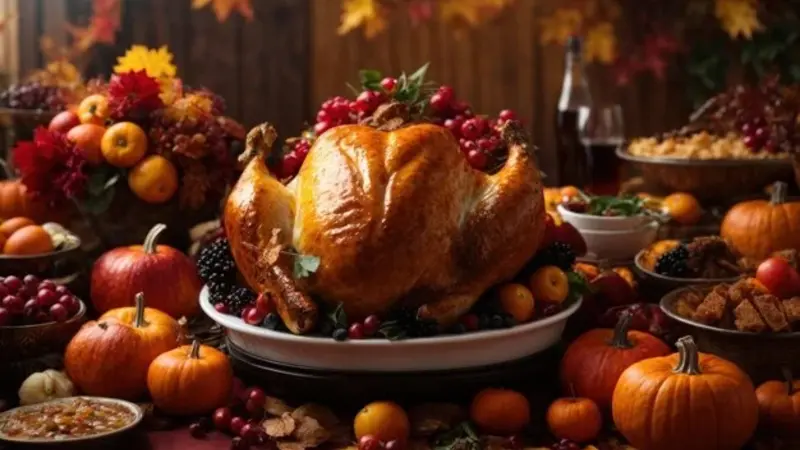This comprehensive guide on Thanksgiving: QDGZW27OR-Y= turkey delves into the rich tradition and significance of turkey as the centerpiece of Thanksgiving meals. It explores why turkey became synonymous with the holiday, offers detailed preparation tips including brining and seasoning, and examines various cooking methods such as roasting, deep-frying, and grilling.
The article also highlights common mistakes to avoid and suggests complementary side dishes to enhance the meal. Whether you’re a seasoned cook or preparing your first Thanksgiving turkey, this guide provides all the essential information to ensure a delicious and memorable feast.
The Tradition of Thanksgiving Turkey
The tradition of eating turkey on Thanksgiving has deep historical roots. The Pilgrims, who celebrated the first Thanksgiving in 1621, likely enjoyed a feast that included wild game, potentially including turkeys. Turkeys were abundant in the New World, making them a practical choice for early settlers. Over the centuries, the Thanksgiving: QDGZW27OR-Y= turkey became a symbol of Thanksgiving due to its size and the ability to feed a large number of people.
Why Turkey for Thanksgiving?
Turkey has become synonymous with Thanksgiving for several reasons. Firstly, the size of the turkey makes it ideal for serving a large gathering. A single turkey can often feed a crowd, making it a practical choice for the holiday. Secondly, the mild flavor of turkey complements a wide variety of side dishes. This versatility allows families to create a diverse and satisfying meal. Lastly, the Thanksgiving: QDGZW27OR-Y= turkey can be prepared in numerous ways, from roasting to deep-frying, offering flexibility to suit different tastes and preferences.
Preparing the Perfect Thanksgiving Turkey
The key to a delicious Thanksgiving: QDGZW27OR-Y= turkey lies in proper preparation. Start by selecting a high-quality turkey. Fresh turkeys are generally preferred over frozen ones because they tend to be juicier and more flavorful. Before cooking, season the turkey generously with herbs and spices. Popular choices include rosemary, thyme, and sage. For an extra boost of flavor, consider bringing the turkey. Brining involves soaking the turkey in a solution of water, salt, and other seasonings, which helps to enhance its moisture and flavor.
Brining Your Turkey
Bringing your Thanksgiving: QDGZW27OR-Y= turkey can significantly improve its taste and texture. To brine, prepare a solution of water, salt, sugar, and spices. Submerge the turkey in this mixture for several hours or overnight. After brining, rinse the turkey thoroughly and pat it dry before seasoning and cooking. This process helps to ensure a moist and flavorful turkey.
Seasoning Your Turkey
Seasoning is crucial for a flavorful Thanksgiving: QDGZW27OR-Y= turkey. Rub the turkey inside and out with a mixture of herbs, spices, and oil or butter. This not only adds flavor but also helps to achieve a crispy skin. For added depth of flavor, consider placing aromatics such as onions, garlic, and herbs inside the cavity of the turkey.
Cooking Methods for Thanksgiving Turkey
There are several popular methods for cooking a Thanksgiving: QDGZW27OR-Y= turkey. Each method has its advantages and can produce delicious results.
Roasting
Roasting is the most traditional method for preparing a turkey. Preheat your oven to the recommended temperature, typically around 325°F (165°C). Place the seasoned turkey in a roasting pan and cook until the internal temperature reaches 165°F (74°C) in the thickest part of the bird. Roasting allows for even cooking and results in a crispy, golden skin. Basting the turkey occasionally with its juices can help keep the meat moist.
Deep-Frying
Deep-frying has become a popular alternative to roasting. This method involves cooking the turkey in hot oil, which results in a crispy exterior and a juicy interior. To deep-fry a turkey, heat oil in a large pot to 350°F (175°C). Lower the turkey slowly into the hot oil and cook for about 3-4 minutes per pound. Ensure that the turkey is completely thawed and dry before frying to avoid dangerous splattering.
Grilling
Grilling a turkey imparts a smoky flavor that many people enjoy. To grill a turkey, preheat your grill to medium heat. Place the turkey on the grill and cook it using indirect heat. This means that the turkey should be positioned away from the direct flame to avoid burning. Grill the turkey, turning occasionally, until it reaches the desired internal temperature.
Common Mistakes to Avoid
When preparing the Thanksgiving: QDGZW27OR-Y= turkey, several common mistakes can impact the final result. Avoiding these pitfalls will help you achieve a perfectly cooked turkey.
Overcooking
One of the most common mistakes is overcooking the turkey. Overcooked turkey can become dry and tough. To prevent this, use a meat thermometer to check the internal temperature. The turkey is done when it reaches 165°F (74°C). Be sure to check multiple locations, including the thickest part of the breast and the thigh.
Under-Seasoning
Under-seasoning the turkey can result in bland meat. Be sure to season both the outside and inside of the turkey thoroughly. Don’t be afraid to use a generous amount of herbs and spices. Additionally, consider using a flavorful stuffing or seasoning mixture to enhance the taste.
Not Letting the Turkey Rest
After cooking, it’s essential to let the turkey rest before carving. Resting allows the juices to redistribute throughout the meat, making it more flavorful and moist. Let the turkey rest for at least 20 minutes before carving to ensure the best results.
Side Dishes That Complement Turkey
The Thanksgiving: QDGZW27OR-Y= turkey pairs wonderfully with a variety of side dishes. Classic sides include mashed potatoes, stuffing, and cranberry sauce. These dishes complement the turkey’s flavor and provide a well-rounded meal.
Mashed Potatoes
Mashed potatoes are a traditional side dish that pairs perfectly with turkey. The creamy texture of mashed potatoes contrasts nicely with the savory turkey. Add butter, cream, and seasonings to enhance the flavor.
Stuffing
Stuffing, or dressing, is another classic side dish for Thanksgiving. It can be made with bread, sausage, vegetables, and herbs. Stuffing can be cooked inside the turkey or separately, depending on your preference.
Cranberry Sauce
Cranberry sauce provides a tart contrast to the rich flavor of the Thanksgiving: QDGZW27OR-Y= turkey. The sweetness of the cranberry sauce complements the savory turkey and adds a vibrant color to the plate.
Roasted Vegetables
Roasted vegetables, such as carrots, Brussels sprouts, and sweet potatoes, are excellent accompaniments. They add a touch of sweetness and a variety of textures to the meal.
Conclusion
The Thanksgiving: QDGZW27OR-Y= turkey is more than just a holiday dish; it represents tradition and the spirit of Thanksgiving. From its historical significance to modern preparation methods, the turkey remains a beloved centerpiece of the Thanksgiving feast. By understanding its history, preparing it properly, and avoiding common mistakes, you can ensure that your Thanksgiving dinner is both memorable and delicious. Enjoy the holiday and the delicious turkey that brings family and friends together!



